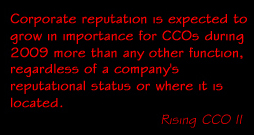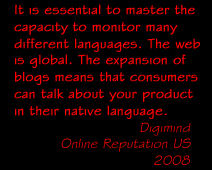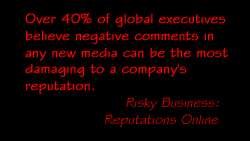Web 2.0, e-reputation and the changing role of the CCO
As Weber Shandwick underscores in Safeguarding Reputation: “Business success and sustainability [have] become increasingly dependent on reputation.”
Digimind’s 56-page study examines in detail how new media have changed the landscape.
Web 2.0 tools have generated a new paradigm that allows customers, consumers, patients, politicians, citizens, business companies, leaders, executives, employees and trades-unionists to express themselves freely on the net. They can unite into communities, talk amongst themselves, and exert pressure on other groups. All this sharing and working together happens in real time, independently from the daily publication of newspapers or the ritual of television newscasts.
A study published on the American blog 97th Floor showed that 29 of the Fortune 100 companies were the subject of “negative” content, as shown on the first page of results found on Google, when you enter their name as a query on the search engine.
(DIGIMIND-WP_ONLINE_REPUTATION.US.2008.pdf, p.20 and 7)
***
How is the role of CCO changing and how are these new responsibilities triggering opportunities for language professionals to support their clients’ needs and objectives?
Corporate communications departments are adding new media and reputation management to their basket of responsibilities at a rapid pace.
Between September and December 2008, Weber Shandwick and SpencerStuart, with KRC Research, conducted their second annual survey on the Rising CCO, polling 159 senior corporate communications professionals (101 from North America, 46 from Europe, and 12 from Asia).

According to the results, for 38% of North American respondents and 46% of European ones, corporate reputation management is now the third most time-consuming part of a CCO’s responsibilities, after media relations and internal communications. One in five European CCOs added a Reputation Management function to their department in 2008 and European CCOs expected it to be their leading priority in 2009.
This shift leads to a reshuffling of the weight of various communications tools used in corporate communications. Media Relations remain the most relied upon resource for 84% and 74% of North American and European CCOs respectively in 2008. However, 18% of North American CCOs, but only 7% of European ones, responded social media/blogging were among the top three tools their department relied on most.
Looking forward, roughly 25% of global CCOs claim the blogosphere will be a significant challenge for their departments, with 30% and 26% of North American and European CCOs respectively expecting social media/blogging to grow most in importance in 2009. As a result, 41% of North American CCOs, but only 22% of European ones, added a social media/blogging function to their departments. It seems some corporate communications departments are going to have to play catch-up in 2010.
The challenge is indeed daunting. It calls for
the capacity to handle the extremely large volumes of information being broadcast: every second in the world, an average of 1.4 blogs are being created, 15 posts added to blogs, 160 instant messages exchanged, more than 500 webpages added or modified and more than 1,000 videos exchanged on YouTube… Even if you continually select which sources have potential influence, a huge amount of power is needed to process these sources.
(DIGIMIND-WP_ONLINE_REPUTATION.US.2008.pdf, p.31)
Weber Shandwick and EIU’s June-July 2008 survey “Risky Business: Reputations Online” points out nearly 60% of global executives expect their on-line reputation management to become more rigorous. This suggests corporate communications departments will need to become more systematic in monitoring and responding to Internet buzz as well as more proactive in their Web 2.0 participation.
***
How does this changing landscape open opportunities for language professionals – copywriters, translators, or intercultural specialists?
Traditional media afford companies the leadtime necessary to “get it right” if they so choose. Smart ones, recognizing the added value of communicating with foreign stakeholders in their own culture and language, make it a point to “think internationally” from project start. For others, producing materials such as their annual report in other languages comes as an afterthought. Rushing the translation/adaptation phase often results in lack-luster and sloppy copy that affects a company’s image.
The increasing role of social media and blogging in corporate communications compresses the timeline drastically. Moreover, it raises specific new challenges for companies acting internationally.

[R]eputation is no longer based purely on what is said in the mainstream media, but increasingly, and perhaps primarily, on what is communicated on the internet. Companies need to professionalize their internet intelligence and integrate it in their mainstream media surveillance processes, turn it into a real “management tool” for corporate communication and products.
(DIGIMIND-WP_ONLINE_REPUTATION.US.2008.pdf, p.32)
Integrated web intelligence services can help companies survey and classify the increasing volume of data sprouting on the WorldWideWeb, yet addressing a potentially harmful buzz or leveraging a burgeoning positive one still calls for interculturally specific human assessment and response.
Language professionals with the right industry expertise are choice partners for corporate clients operating internationally. Beyond their traditional role of crafting or translating copy used in traditional media (press releases, static websites, annual reports, brochures and so on), language professionals can offer new services to their clients, such as:
- Defining corporate editorial and language charters, to ensure harmony in tone, style, and terminology regardless of author or publication platform
- Monitoring and analyzing specific influential blogs and social communities, or even acting as moderator or discussion leader for company/brand on-line communities
- Collaborating with in-house project teams responsible for writing blog posts, responding to comments and taking part in social media platforms to produce multilingual adaptations in almost real-time.
Clearly, a compressed time-line combined with the need for innovative language services will change the traditional (often time-consuming) modus operandi between client and specialist, typically based on a quote for a particular document and set of specifications. This piecemeal approach is not suited to the changing paradigm. Both parties need to rethink how to work together, with a broader scope and longer view. Package-based and/or subscription types of business models are one alternative.
Companies need to recognize professional language and cultural services are an investment in their image and their turnover. Re-polishing a tarnished reputation on the Internet takes time and costs a bundle: digital archives are eternal and Web surfers unforgiving.
The frontier between traditional and new media is starting to look like lace.
How are language experts and their corporate communications clients working together to leverage the opportunities offered by this changing space?
Special thanks to Elizabeth Rizzo, Vice-President, Reputation Research at Weber Shandwick in New York, for sending me the full presentations of two surveys referred to in this post, “The Rising CCO II” and “Risky Business: Reputations Online”.
Tags: blogging, blogosphere, CCO, corporate image, e-reputation, language and reputation, linkedin, reputation management, social media, translation and corporate image, Web 2.0, Weber Shandwick






[…] This post was mentioned on Twitter by Anthony Poncier, Digimind. Digimind said: Web 2.0, e-reputation and the changing role of the CCO http://bit.ly/4qO42p […]